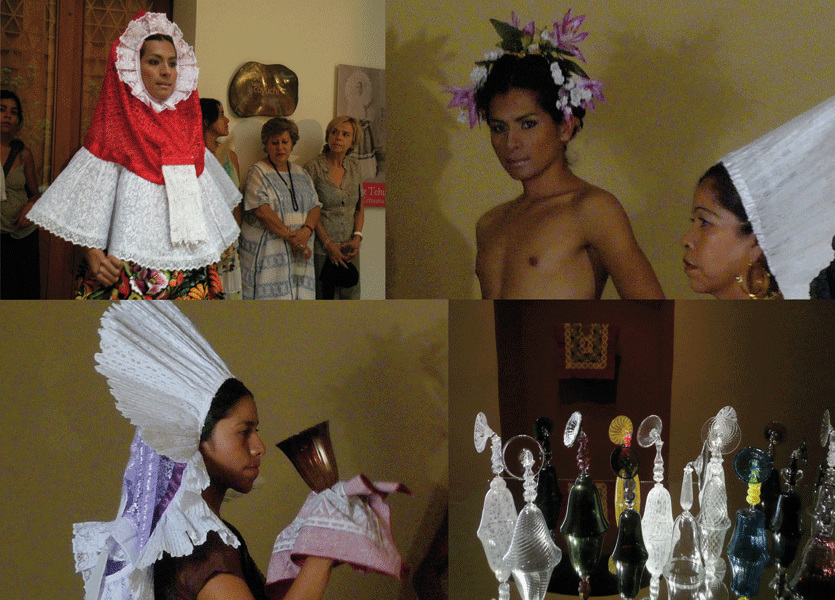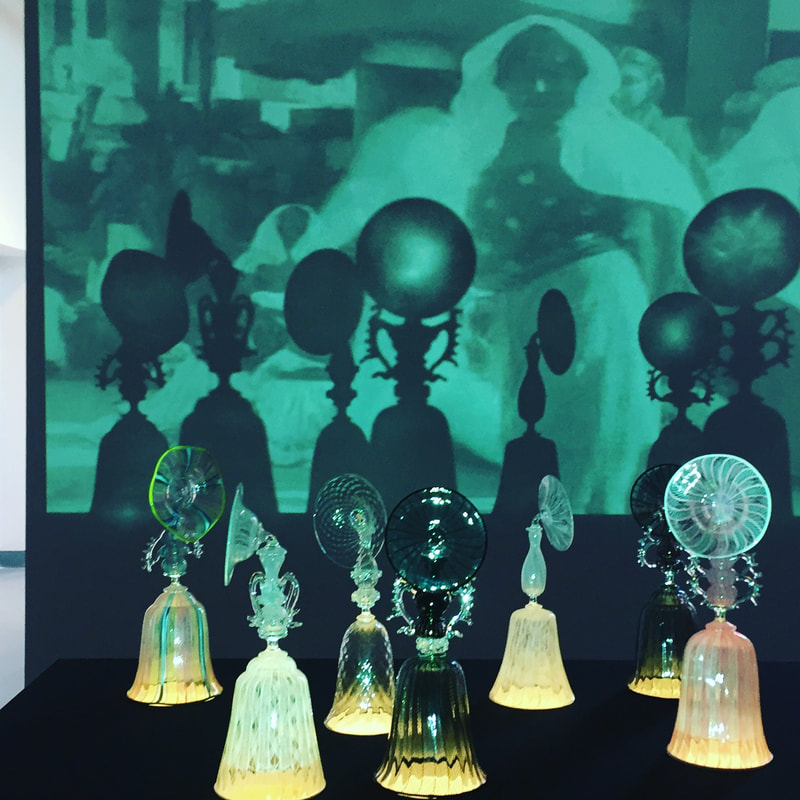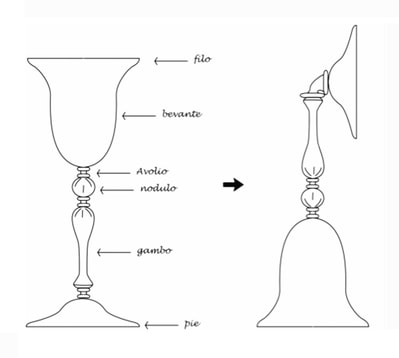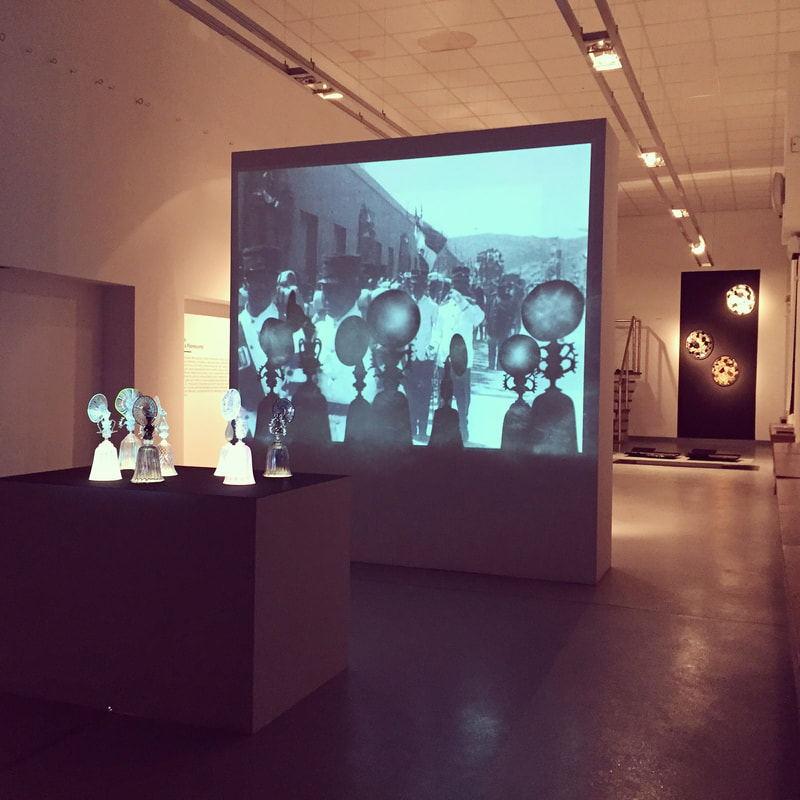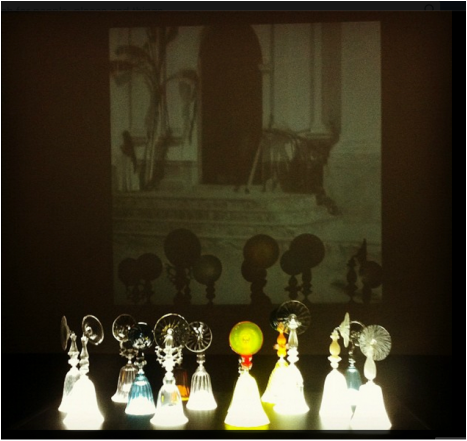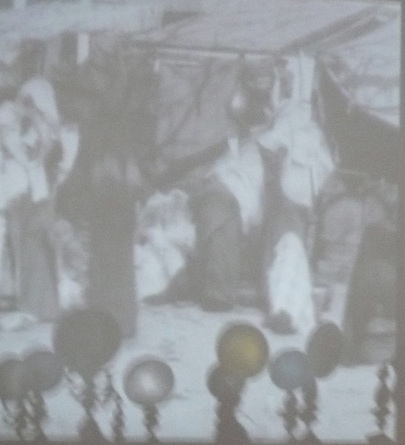TEHUANA GOBLET installation. 2012.
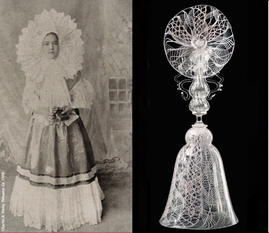
Media/technique: hand blown “Verre à la façon de Venise.” goblets
Dimensions: tall 33cm. foot 12 cm. Cup 11 cm. Weight 300 grms. (aprox) .
Goblets Credits: Treg Silkwood
Goblets Photo Credits: © lente 3030: Meinolf Koessmeier, Xavier Carrillo, Luis Aguilar
The Tehuana Goblet is a collection of hand blown glass pieces inspired in the subtle relationship between a filligrana crystal goblet (a large ritual cup in the style known as "Verre à la façon de Venise", and the traditional garment of the isthmus of Tehuantepec region in Oaxaca, Mexico.
In these pieces, the goblets are slightly altered by bending the foot to a 90 degree angle on the side, thus reversing its standing point. The foot therefore resembles the head dress of the zapotec women called the "bida:niró", which is translated in spanish to "Resplandor" or “Gleam” in english, a spectacular confection of starched plated lace that frames the face like an aureole.
Ever since its archetypal construction during the 1920s, the Tehuana symbolizes a mixture of beauty and resistance through identity. After a venetian goblet is anthropomorphized into a zapotec woman. This starts a dialogue with ornament, hypnotic seduction and sublime craft. The installation is born from the archival image. I use footage from my great grandfather Salvador Toscano who filmed the Tehuanas circa 1914. Interweaving glass and textile paths from Venice to Mexico. The artistic intention of The Tehuana goblet is to explore from a contemporary point of view, a de- colonization process between the arts and crafts. Noting intersections between the manufacture and the role of artisanal materials such as glass and textiles.
Dimensions: tall 33cm. foot 12 cm. Cup 11 cm. Weight 300 grms. (aprox) .
Goblets Credits: Treg Silkwood
Goblets Photo Credits: © lente 3030: Meinolf Koessmeier, Xavier Carrillo, Luis Aguilar
The Tehuana Goblet is a collection of hand blown glass pieces inspired in the subtle relationship between a filligrana crystal goblet (a large ritual cup in the style known as "Verre à la façon de Venise", and the traditional garment of the isthmus of Tehuantepec region in Oaxaca, Mexico.
In these pieces, the goblets are slightly altered by bending the foot to a 90 degree angle on the side, thus reversing its standing point. The foot therefore resembles the head dress of the zapotec women called the "bida:niró", which is translated in spanish to "Resplandor" or “Gleam” in english, a spectacular confection of starched plated lace that frames the face like an aureole.
Ever since its archetypal construction during the 1920s, the Tehuana symbolizes a mixture of beauty and resistance through identity. After a venetian goblet is anthropomorphized into a zapotec woman. This starts a dialogue with ornament, hypnotic seduction and sublime craft. The installation is born from the archival image. I use footage from my great grandfather Salvador Toscano who filmed the Tehuanas circa 1914. Interweaving glass and textile paths from Venice to Mexico. The artistic intention of The Tehuana goblet is to explore from a contemporary point of view, a de- colonization process between the arts and crafts. Noting intersections between the manufacture and the role of artisanal materials such as glass and textiles.
Glass Huipiles
Claudio Linati, the italian artist who introduced litography in México, must have fell in love with the women of the Isthmus. His tehuana, tangled in a tight enredo (a kind of skirt consisting on a rectangular piece of cloth that sits around the hips) and transparent huipil revealing beautiful breasts, break the Puritan austerity of a long series of civil and military garments that Linati recorded & engraved in the second decade of the XIX century.
The ruffle lace that frames the “istmeña” face appears more noticeable, by her unexpected nakedness. After drawing many coats and skirts made of fleece from the neck down, the artist revels in the light freshness of this charming woman. On her shoulders a glass gleam appears to float.
Perhaps it is no coincidence that a man of Italy payed attention to the garment of the Isthmus.. In this exhibition, Valeria Florescano discovers fine tunes between the glass of Murano and the diaphanous figure of the “bidaaniró' ”, the Zapotec white gala blouse women wore for special occasions. Filigree glass, lace starched linen; red hot blown glass, Valencia pleated with a very hot iron. These obvious parallelism do not make justice to the work of Valeria. Her curiosity leads to more subtle findings on the forms and textures of seduction. The Tehuana of Linati flirts between chalices. The glasses stand, awaiting the touch of brown skin.
Alejandro de Ávila B.
Curator, Textile Museum of Oaxaca.
Claudio Linati, the italian artist who introduced litography in México, must have fell in love with the women of the Isthmus. His tehuana, tangled in a tight enredo (a kind of skirt consisting on a rectangular piece of cloth that sits around the hips) and transparent huipil revealing beautiful breasts, break the Puritan austerity of a long series of civil and military garments that Linati recorded & engraved in the second decade of the XIX century.
The ruffle lace that frames the “istmeña” face appears more noticeable, by her unexpected nakedness. After drawing many coats and skirts made of fleece from the neck down, the artist revels in the light freshness of this charming woman. On her shoulders a glass gleam appears to float.
Perhaps it is no coincidence that a man of Italy payed attention to the garment of the Isthmus.. In this exhibition, Valeria Florescano discovers fine tunes between the glass of Murano and the diaphanous figure of the “bidaaniró' ”, the Zapotec white gala blouse women wore for special occasions. Filigree glass, lace starched linen; red hot blown glass, Valencia pleated with a very hot iron. These obvious parallelism do not make justice to the work of Valeria. Her curiosity leads to more subtle findings on the forms and textures of seduction. The Tehuana of Linati flirts between chalices. The glasses stand, awaiting the touch of brown skin.
Alejandro de Ávila B.
Curator, Textile Museum of Oaxaca.

